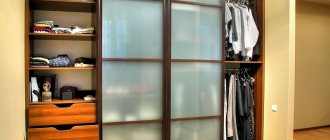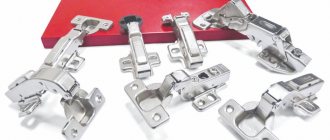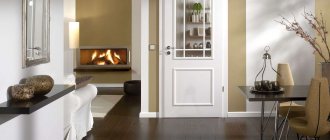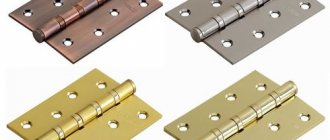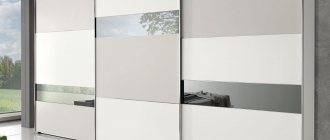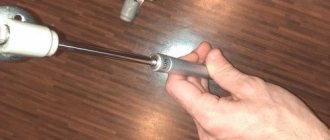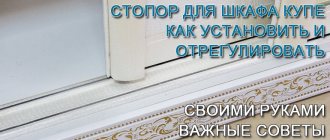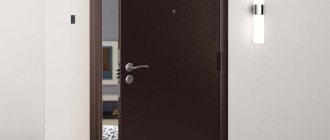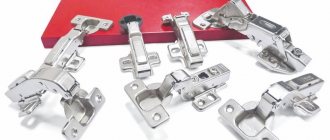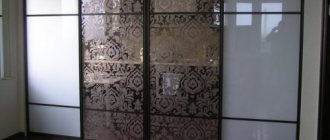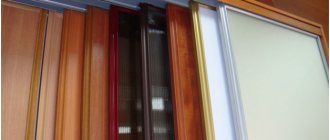Door hinges perform the most important function - they hold the door suspended and attach it to the door frame structure. The correct operation of the door depends on their choice, and this also determines the durability of the door mechanism. There are many types of hinges; for each type of door you can choose the optimal hinge. Construction stores offer hidden hinges, butterfly hinges, card hinges, etc. Today we will look at each of these types in detail. Here you can find out what types of loops there are.
Classification of loops
A hinge is a device with which the door leaf is attached to the frame. Hinges can be screwed or hinged, detachable or permanent, left or right. Detachable hinge - you can remove the door from it without unscrewing the hinges. A permanent (universal) hinge is one that will have to be unscrewed before removing the door. Wings are small plates with holes on the sides of the hinge, with the help of which it is attached to the door. Door leaf is what sellers call the door itself. Door frame - frame for a door. Euro-narthex - protrusions at the ends of the door.
Those who have ever bought new doors probably know: a lot of doors are now sold complete with door hinges, locks and handles. On the one hand, this is good. There is no need to worry that some unfortunate craftsman will screw the hinges in the wrong way, in the wrong place, or scratch the door leaf.
Hinge - a device with which the door leaf is attached to the frame
On the other hand, this still limits your freedom of choice and forces you to take the purchase of hinges more seriously. But if you already have a door and you just want to change the fittings, there is nowhere to go: you will have to go shopping.
Of course, you can put a new door on old hinges, but if you have enough money for a door, don’t be greedy, the price of a hinge is incomparably less than the price of a door.
It is extremely difficult to ruin a door hinge unless it is a cheap, homemade iron hinge. However, if your child happily uses the door instead of a swing, then the inner pin of the hinge may bend. Screw-in hinges also pose some danger: when screwed into a fairly thin door leaf with a Euro-seal, they can split it.
Hinges for entrance doors differ from interior doors in larger sizes. Entrance doors are usually heavier (80–150 kg) and stronger. In addition, manufacturers of hardware for entrance doors have figured out how to protect an apartment from uninvited guests: to prevent the entrance door from being removed from its hinges, companies produce hinges with an anti-removal mechanism.
There is a depression on one wing and a protrusion on the other. When the door is closed, the wings are aligned, the protrusion fits into the recess and prevents the door from being lifted. First of all, you need to know the weight of the door leaf. And when buying hinges, be sure to get advice on how many pieces you need to buy. All manufacturers have graphs of the dependence of the quantity, material and type of hinge on the weight of the door. How to decide the price?
The price range for loops is quite wide. It depends on the size of the loop and the material from which it is made. The location of the hinge is also important: the heavier the door, the more carefully it must be secured. A diagram that will help you determine which door hinges you need - left or right.
The universal door hinge is suitable for almost any door, no matter which way it opens - outward or inward. But these door hinges are one-piece. For example, if you need to bring a bulky item into the room - a wardrobe or a sofa, then you can remove the door only by unscrewing all the door hinges from it.
Therefore, for lovers of rearrangements in the apartment, we advise you to opt for left or right door hinges. They, unlike universal ones, are detachable. If necessary, the door is raised and removed from its hinges. In this they are similar to screw-in door hinges.
The only catch is that before purchasing you need to decide which way the door will open. How to do it? Stand in front of the intended door so that it opens “toward you.” If you want the door hinges to be on the right hand, you need right-handed door hinges, if on the left, you need left-handed ones. Here is a clear example: look at the diagram of the Swedish company ASSA. All clear? Although... wait until you draw conclusions.
Hinge material
- Steel. Modern technologies have returned such canopies to their former popularity. There are enough varieties of them - forged, with anti-corrosion coating, made of stainless steel. All these hinges are characterized by increased strength, and therefore they are recommended for installation on entrance doors.
- Alloys. They contain various metals - aluminum, zinc, copper. The decoration of such canopies is done by powder coating and painting with enamels. They are stylized as antique, “gold”, “bronze” - the choice is huge. But in terms of reliability, they are inferior to steel hinges, and therefore are mainly installed on apartment or interior doors. It is not advisable to use it to protect the entrance to a private home.
- Brass. In terms of durability, such canopies can compete with their steel counterparts, but in terms of strength they are significantly inferior. Mainly used when installing internal doors; They are cheap, easy to polish, and if a defect occurs, replacing them is not a problem.
As a rule, fasteners are also sold complete with hinges. The material of the screws is no less important than the canopies themselves. If the hardware is made of soft metal, then there will be problems with installation; There is a high risk that the splines will easily “break” when screwed into a solid surface, especially when working with a power tool.
Types of interior door hinges
Since there are both entrance and interior doors, the types of door hinges for each case will vary. For entrance groups, more massive hinges are produced; they are designed for use in conjunction with heavy entrance doors.
Their difference is not only in size. Hinges for entrance doors have a special mechanism to resist the leaf; it eliminates the possibility of lifting the door leaf. This device consists of depressions and protrusions, which, when combined in the closed position, do not allow the canvas to move up/down after alignment with the box. We are considering the installation of interior doors and the subsequent selection of hinges.
Hinges for folding doors
Folding interior doors entered the interior of our apartments relatively recently. Normal operation of doors of this design, consisting of separate sections, is ensured by special fittings included in the kit.
Hinges for folding interior doors are predominantly mortise, of a special design. Their goal is to connect the doors, of which there may be several, above and below.
Each type of door uses its own type of fittings, the quality of which determines not only the appearance, but also the service life of the door.
Features of detachable and universal hinges
Removable hinges are sometimes called removable or canopy hinges. Their difference is that the canvas suspended in this way can be removed without dismantling the loop. From the picture you can get acquainted with how the detachable hinge mechanism works.
Both elements of such a device have their own names, which were given to them by folk wisdom. Now the words “dad” and “mom” have become generally accepted, they are used by both ordinary people and professionals.
Universal hinges are one-piece. To remove the canvas secured with such a mechanism, the loop must be unscrewed. Universal models are used on doors that open both inward and outward. However, many consider the need to unscrew all fasteners when removing the canvas to be inconvenient.
Universal and detachable hinges
Such types of simple door hinges as detachable ones allow you to lift and remove the sash without unscrewing the fastening. Removable hinges have been popularly called “awnings” for a long time; this name has firmly entered into everyday use.
The design of the canopies consists of two parts, wittily called “male” and “male”, a term used by many experts and users in some countries.
Universal hinges
Universal hinges for interior doors will have to be unscrewed if there is a need to remove the sash. They are suitable for door structures that open both outward and inward, which can be considered a definite plus. However, the need to unscrew fasteners causes certain inconvenience and loss of time, which should be considered a big disadvantage.
Types of hinges depending on design features
Overhead/mortise hinges
GOST 5088-2005 regulates the requirements for overhead and mortise hinges. In this document there are practically no fundamental differences between these two types of structures. The fact is that the main part of the mechanism is the same. This can be seen in the figure below.
Both of these types have card-type loops. One is attached to the canvas, the other to the box. However, the opening and the canvas for each of these types is prepared in its own way:
- the overhead type is attached directly to the surface;
- For installation of the mortise type, recesses are made into which card loops are placed. The history of overhead loops goes back more than one century. In ancient times, overhead door hinges were forged from steel strips. A symmetrical shape was not the goal of the blacksmiths' work. They strived for variety, ornate forms and, of course, strength. The dimensions of those ancient hinges were much larger than modern ones. Each product was unique, bearing the imprint of the style of the master who forged it.
Today, when recreating the retro style, designers also design door hinges, repeating the bygone rules and traditions of manufacturing this part of the door structure. To produce these parts, designers turn to masters of artistic forging. The popularity of overhead hinges is associated with the ease and high speed of their installation. The plates are screwed on with screws, after which the door is installed in the opening.
Physical and time costs are minimized. In recent years, a type of overhead model called “butterfly” door hinges has been gaining popularity. The special shape of the cutout, similar in appearance to a butterfly wing, allows the mechanism to fold so that the thickness of the product corresponds to one half. No cuts are made for such a loop either on the box or on the canvas.
In terms of their properties, mortise models are in many ways similar to overhead ones. Only to install them you need to make a cutout for the hinge plate. Recesses are made both on the box and on the canvas, namely in its end part. This product is fastened with screws. When a door suspended on mortise hinges is in the closed position, only the pivot pin can be seen from the outside.
If we compare overhead detachable models and universal ones, it should be noted that the universal door hinge has a more durable and rigid structure. Therefore, even with small sizes, these devices cope with fairly large loads. By choosing this type, you protect the door structure from subsequent sagging.
Overhead detachable hinges can be right-handed or left-handed. You need to be careful when purchasing so as not to make a mistake. In the case of universal models, there is no need to worry about this. There are no restrictions on the side of the door opening.
Screw-in (screw-in) hinges
Screw-in hinges are devices consisting of 2 parts shaped like a cylinder. The component parts are located symmetrically relative to each other. The product is equipped with holes for fastening. One “barrel” is mounted to the canvas, the other to the box. Screw-in hinges are considered universal because there are no right or left elements. The main property of screw-in hinges is the solidity of the fastening. There is no way to remove such a door from its hinges. Perhaps this is not only an advantage, but also a significant drawback. But many people acquire loops of a similar design precisely because of this property.
Corner hinges
The corner hinge can be distinguished from other analogues by the method of attaching the axial rod. There are no standard wings fixed near the rod, which occupies a central position. In this case, profile corners will be attached to it. In essence, these are the same card awnings, only in the shape of an angle. This shape gives them some advantages, such as the ability to mount hinges on rebated doors.
Corner door hinges for rebated doors are attached in the same way as mortise door hinges. One corner is recessed into the end of the door and secured with screws. The main disadvantage of this design is that the device is clearly visible and not hidden in any way.
Secret hinges
Secret hinges are not afraid of picky looks. They are practically invisible when the door is in the closed position. This fact adds aesthetics to the entire appearance of the door, which is why this fastening is considered elite and is in great demand.
Ease of use is facilitated by the absence of the need to distinguish between right and left hinges during installation.
Hidden door hinges have 3 rotary axes and are not easy to install. Therefore, not everyone can cope with such a matter on their own. If you decide to install hidden hinges, it is recommended to use the services of professionals.
Double-sided hinges
Double-sided hinges are essentially the same card canopies. The main property of these mechanisms is to ensure that the door leaf works in 2 directions. On these hinges the door leaf will move both forward and backward. This function is not in demand in living space. Therefore, double-sided hinges are not installed in apartments. But in public institutions - quite often, especially on the entrance doors.
Types of loops
Hinges for all types of windows can be adjustable or non-adjustable. In modern designs, the first version of devices is most often used, which can be made of brass, steel or aluminum alloys. In this case, plastic can only be used for decorative overlays. According to their purpose, these mechanisms are classified into:
- overhead – a reinforced modification used to complete very heavy sashes;
- rotary - traditional hinges that are used to equip door and window sashes that open outward or inward;
- folding - devices designed to open the sashes into a folding position.
Based on the installation method, these mechanisms are divided into semi-hidden, overhead and completely hidden. The most common is the first modification, and the most promising is the last. Hidden hinges provide better tightness and aesthetics of the doors. Read more about devices of this type on OknaTrade. In turn, semi-hidden loops are divided into:
- mortise;
- screw-in;
- semi-overhead.
When choosing hinges, you must simultaneously pay attention to several parameters of the doors - their dimensions, weight, as well as requirements for burglary resistance class and functionality.
Varieties of models by material and type of coating
Steel products never go out of fashion. In the past, blacksmiths were famous for their ability to make a wide variety of things from steel, including door canopies. Today, alloy hinges are used for doors that are used indoors or at the entrance. Most often, alloys of aluminum and brass are used for this.
Steel is used for artistic forging products produced to order. In the Soviet years, hinges were an ordinary type of product; all products were the same and unattractive. No protective or decorative coatings were used in the production of the hinges.
Therefore, the hinges had to be painted with conventional paints and varnishes before use together with the canvases. Today, “Soviet” type canopies are installed in utility rooms and on the street. In apartments and houses they install hinges made of stainless steel or forged products, stylized in an “antique” style.
Door hinges of various designs and colors are available for sale. Color variations are achieved through the use of various coatings. For this, enamels and special compositions are used. The result is loops with a “gold” or “bronze” color. There are chrome plated products, plated with brass and some others.
Door hinges are available in a variety of designs and colors.
Hinges are made from alloys of aluminum, zinc, steel, and copper. During the production process, coatings are applied to the products to protect the mechanisms from corrosion and give them a modern, attractive appearance. This makes it possible to choose an option that optimally matches the design of the room, to coordinate the color and style of the canopies with other elements of fittings and decor used in the space.
The world's leading manufacturers avoid brass coatings. They make them entirely from this material. This eliminates the problem of abrasion, they look great after polishing, and last a very long time. Brass hinges are considered as durable and reliable as steel devices. However, their price is quite high, so not everyone can afford to purchase them. Before purchasing, you need to make sure that the product is not counterfeit.
Counterfeits do not last long, quickly lose their appearance, and in a short time lead to sagging door panels. This is due to the materials that go into their production. They may unexpectedly collapse, causing the canvas to fall and injure surrounding people.
Hidden hinges
You can choose hinges for doors, both hidden and external, in the Portal online store. High-quality, reliable structures are usually expensive, and their installation requires the use of special tools and specialist knowledge.
Pros and cons of hidden hinges
Hidden hinges for doors are installed only by specialists using certain equipment. Such a hinge is placed inside the door leaf and frame. Such fittings are considered an aesthetically beautiful option, thanks to the creation of an ideal picture of a flat surface. It is impossible to cut down such a door. Hidden products have many advantages, including safety, ease of use and beauty. Hidden components will also have a lot of disadvantages, which, in addition to installation difficulties, will include expensive production and limited functionality during operation.
Cons of hidden hinges
Simple hinges made of cheap metal will have a lot of disadvantages that can easily be explained by the quality of the material, but more expensive options also have disadvantages. These include:
- small door opening radius;
- high cost of the entire door structure with built-in hinges;
- reduced structural safety due to the cut-out space in the box;
- reduced tightness by installing one sealing circuit instead of two.
Despite their beautiful appearance, the installed hidden hinges have some disadvantages that interfere with full comfortable operation.
Hinges for metal doors: types and their features
In fact, if you don’t get into the small details, you can distinguish only two main types of awnings for metal doors - they are practically not inferior to each other in popularity. Some of them are cheaper and can withstand heavy loads, while others ensure the reliability of the door block. In general, both hinges for iron doors have a lot of advantages, which we will talk about later.
Hinges with bearing for doors
Bearing hinges for doors are the most common type of hinges for metal doors.
This is the most common type of canopy for metal doors, which have been successfully used for quite a long time, and their main difference is the presence of a simple bearing, which is an ordinary ball, which is inserted between the halves of the hinges.
It is this ball that allows this type of hinge to be used for doors of almost any weight - it is this ball that ensures the free and easy movement of the door leaf, regardless of the load on the hinges. There are two main subtypes of hinges of this type - these are ordinary cylindrical hinges on bearings and the so-called teardrop-shaped canopies. The only difference between them is ease of installation.
Before installation, ordinary cylindrical canopies are welded to small plates, which should provide a small gap between the canopy and the door, but teardrop-shaped ones do not need such manipulations. It is the shape of the drop that allows for this gap. Also, often for the installation of cylindrical canopies, not plates are used, but a thin rod, which, after welding to the canopy and appropriate processing with a grinder, gives it the same drop shape.
